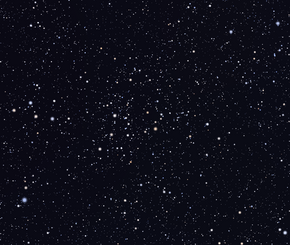| NGC 2354 | |
|---|---|
 NGC 2354 (taken from Stellarium) | |
| Observation data (J2000 epoch) | |
| Right ascension | 07h 14m 10s [1] |
| Declination | –25° 41.4′ [1] |
| Apparent magnitude (V) | 6.5 |
| Physical characteristics | |
| Other designations | Cr 131 |
| Associations | |
| Constellation | Canis Major |
NGC 2354 is an open cluster in the constellation Canis Major. It lies 2 degrees southwest from NGC 2362 and northeast of Delta Canis Majoris. About 15 member stars are visible through binoculars. [2]